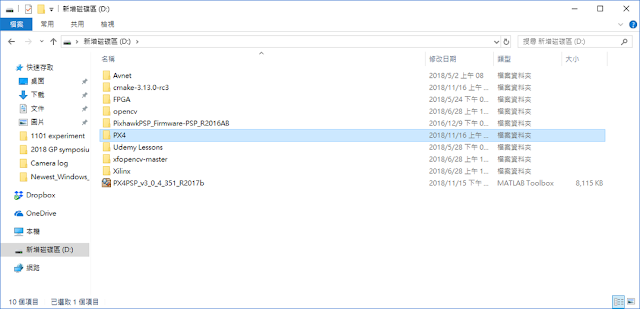Intel RTF auto takeoff and landing using stereo visual odometry via mavlink
Method1: MavROS
Step1: Install ROS [1]Step2: Download and run PX4 Gazebo simulator ( Install the development toolchain! [2] )
Step3: Create ROS workspace, make and run ROS node
( fcu_url:="tcp://192.168.8.1:5760")
Think: How to revise the following part to the result of stereo VO ?
geometry_msgs::PoseStamped pose;
pose.pose.position.x = 0;
pose.pose.position.y = 0;
pose.pose.position.z = FLIGHT_ALTITUDE;
***模仿***
1. https://github.com/OsloMet1811/Digital-Twin/tree/master/drone_mocap
2. https://www.youtube.com/watch?v=iysofezsteA
3. https://github.com/PX4/Firmware/issues/6364#issuecomment-410481134
4. https://github.com/mavlink/mavros/tree/master/mavros_extras
Install VRPN:
1. Compiling
2. https://github.com/vrpn/vrpn/wiki/Writing-Servers
Parameters for Intel RTF:
1. State estimator: EKF2
2. Mavlink pose data: ATT_POS_MOCAP
3. EKF2_AID_MASK: 8
4. EKF2_HGT_MODE: Vision
5. EKF2_EV_DELAY: 30ms
1. https://github.com/OsloMet1811/Digital-Twin/tree/master/drone_mocap
2. https://www.youtube.com/watch?v=iysofezsteA
3. https://github.com/PX4/Firmware/issues/6364#issuecomment-410481134
4. https://github.com/mavlink/mavros/tree/master/mavros_extras
Install VRPN:
1. Compiling
2. https://github.com/vrpn/vrpn/wiki/Writing-Servers
Parameters for Intel RTF:
1. State estimator: EKF2
2. Mavlink pose data: ATT_POS_MOCAP
3. EKF2_AID_MASK: 8
4. EKF2_HGT_MODE: Vision
5. EKF2_EV_DELAY: 30ms
Reference:
1. https://github.com/UCM-M143/MavRos-takeoff-n-land
2. https://dev.px4.io/en/setup/dev_env_linux.html#jmavsimgazebo-simulation
3. https://dev.px4.io/en/ros/external_position_estimation.html
4. PX4 Offboard Control Using MAVROS on ROS
5. https://mavlink.io/en/messages/common.html
Method2: MavKit
Reference:
3. https://github.com/qianrenzhan/mavkitvs2015
Reference:Method3: Mavlink C++ library
Step1: Download mavlink library v1
Step2: Put all files of library v1 in a "include" folder
Step3: Put mavlink_udp.c in a "src" folder
Step4: build project
gcc main.cpp -I'/home/namikilab/Downloads/c_library_v1-master/include' -o mavlink_udp
Reference:
Step2: Put all files of library v1 in a "include" folder
Step3: Put mavlink_udp.c in a "src" folder
Step4: build project
gcc main.cpp -I'/home/namikilab/Downloads/c_library_v1-master/include' -o mavlink_udp
Reference:
1. MAVLink UDP Quickstart Instructions
2. https://github.com/mavlink/c_library_v1
2. https://github.com/mavlink/c_library_v1
Method4: RTPS(real time publish subscribe)
Reference:
2. https://dev.px4.io/en/setup/fast-rtps-installation.html
3. https://wiki.dronecode.org/workgroup/messaging/start
4. https://github.com/eProsima/PX4-FastRTPS-PoC
5. https://github.com/edersondisouza/Firmware/commits/test-rtps-share
6. PX4 Pro Drone Autopilot
3. https://wiki.dronecode.org/workgroup/messaging/start
4. https://github.com/eProsima/PX4-FastRTPS-PoC
5. https://github.com/edersondisouza/Firmware/commits/test-rtps-share
6. PX4 Pro Drone Autopilot
Method5: MAVLink Router
To do: Offboard PC should be able to communicate with Drone directly by setting endpoints!
Reference:
Reference:
1. https://github.com/intel/mavlink-router
2. https://github.com/intel/mavlink-router/blob/master/examples/config.sample
3. https://github.com/mavlink/c_library_v2 (mavlink v2 should be included while testing examples)
2. https://github.com/intel/mavlink-router/blob/master/examples/config.sample
3. https://github.com/mavlink/c_library_v2 (mavlink v2 should be included while testing examples)
Method6: C++ UART MAVLink
1. https://github.com/mavlink/c_uart_interface_example
2. http://discuss.px4.io/t/cant-send-external-position-estimation-with-mavlink-c-library/5745
3. https://github.com/rijesha/mavlink-interface
4. https://mavlink.io/en/messages/common.html


留言
張貼留言